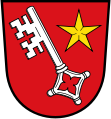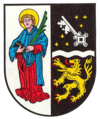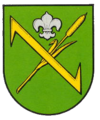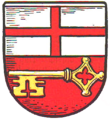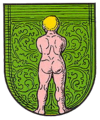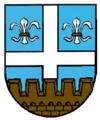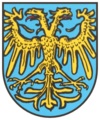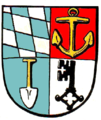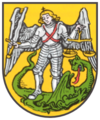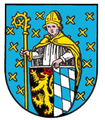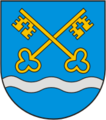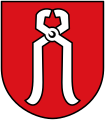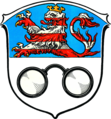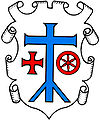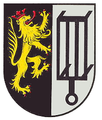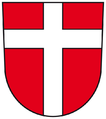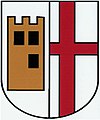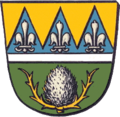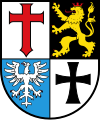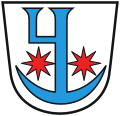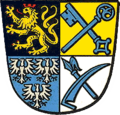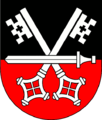List of coats of arms of the independent cities in Rhineland-Palatinate
Independent cities in Rhineland-Palatinate
Historical coats of arms of the independent cities
Frankenthal (Palatinate)
The current coat of arms was introduced on November 27, 1954 and replaced the coat of arms that can be seen here. This was introduced on July 27, 1841. The diamond stands for the three major ethnic groups in Frankenthal at that time: Dutch, Walloons and Germans. Flomersheim , Mörsch and Studernheim
were incorporated into Frankenthal in 1919 , and Eppstein in 1969 .
Frankenthal 1841-1954
Flomersheim until the late 19th century (unapproved)
Mörsch 1919–1987 (unapproved)
Mörsch since May 8, 1987
Studernheim until 1919 (unapproved)
Eppstein since June 27, 1841
Kaiserslautern
Kaiserslautern was incorporated in 1969 Dansenberg , Erfenbach (1937 Stockborn ), Erlenbach , Hohenecken , Mölschbach , Morlautern and Siegelbach
Dansenberg since September 14, 1949
Erfenbach since December 5, 1922
Erlenbach since March 22, 1926
Hohenecken since November 27, 1926
Mölschbach since May 16, 1960
Morlautern before 1960 (not official)
Morlautern since March 9, 1960
Siegelbach since March 28, 1927
Koblenz
In 1937 Ehrenbreitstein, Horchheim, Metternich, Pfaffendorf were incorporated; 1969 Güls, Kesselheim, Stolzenfels; 1970 Arenberg, Arzheim, Bubenheim, Immendorf , Lay and Rübenach
Landau
The current coat of arms was introduced on January 10, 1961 and shows the imperial eagle as a shield in front of the lion, as the city became a free and imperial city as early as the late 13th century. On January 4th 1907 a coat of arms was confirmed with a castle and two horn blowers in the towers, this reconstructs the oldest seal from 1286. A bad reconstruction was used before 1907.
There were also some incorporations: 1937 Mörlheim, Queichheim; 1972 Arzheim, Dammheim, Godramstein, Mörzheim, Nussdorf and Wollmesheim
Landau before 1907
Landau 1907-1961
Arzheim before 1956 (unapproved)
Dammheim since December 12, 1956
Godramstein since June 14, 1844
Mörzheim since December 2, 1927
Nussdorf since June 14, 1944
Wollmesheim since October 25, 1937
Ludwigshafen am Rhein
Today's Ludwigshafen coat of arms (anchor) was awarded as early as 1853. With the incorporation of Friesenheim in 1895, its spades and the Wittelsbach diamonds were taken up by the Palatinate and Bavaria . After Mundenheim was incorporated, its key was taken. In 1937 Ludwigshafen returned to the original coat of arms. As a result, Maudach, Oggersheim and Oppau were incorporated in 1938, and Ruchheim in 1974. Edigheim had already joined Oppau in 1929, so that the common place still had its own coat of arms for a short time
Ludwigshafen am Rhein 1895–1900
Oggersheim until 1980
Mainz
Incorporation: 1907 Mombach ; 1908 Kastel (until 1945), Amöneburg (until 1945); 1913 Kostheim (until 1945); 1930 Bischofsheim (until 1945) Bretzenheim , Weisenau ; 1938 Ginsheim (until 1945), Gonsenheim ; 1969 Drais , Ebersheim , Finthen , Hechtsheim , Laubenheim , Marienborn
Neustadt an der Weinstrasse
Incorporation: 1892 Winzingen; 1969 Diedesfeld, Geinsheim, Gimmeldingen (which had incorporated Lobloch in 1860), Haardt, Hambach, Königsbach, Lachen-Speyerdorf, Mußbach; 1974 Duttweiler
Pirmasens
Incorporation: 1969 Erlenbrunn, Winzeln; 1972 Gersbach, Windsberg
trier
Incorporation: 1888 St. Paulin, Maar, Zurlauben, Löwenbrücken, St. Barbara; 1912 Heiligkreuz, St. Matthias, St. Medard, Feyen; 1930 Euren, Biewer, Pallien, Kürenz, Olewig; 1969 Ehrang-Pfalzel, Eitelsbach, Filsch, Irsch, Kernscheid, Ruwer, Tarforst, Zewen.
Worms
Incorporation: 1898 Hochheim, Neuhausen, Pfiffligheim; 1942 Herrnsheim, Horcheim, Leiselheim, Weinsheim; 1969, Abenheim, Heppenheim, Ibersheim, Pfeddersheim, Rheindürkheim, Wiesoppenheim
Zweibrücken
Incorporation: 1938 Ixheim, Niederauerbach; 1972: Mittelbach-Hengstbach (which emerged from Mittelbach and Hengstbach in 1969), Oberauerbach, Rimschweiler
Blazons
- ↑ Frankenthal (Palatinate) : In black a red armored, tongued and crowned golden lion, carrying a golden orb in the raised right paw, holding a red shield with the left, inside a triangular golden corner stone with the tip turned upwards.
- ↑ Kaiserslautern : In red a silver pole, topped with a vertical blue fish.
- ↑ Koblenz : A continuous red cross in silver, topped with a golden crown.
- ↑ Landau : In a red shield border in silver a red armored and tongued black lion, covered with a gold heart shield, inside a red armored black eagle.
- ↑ Ludwigshafen : In red, a lowered golden anchor.
- ↑ Mainz : In red, two inclined, six-spoke silver wheels connected by a silver cross.
- ↑ Neustadt : In black a red armored, tongued and crowned golden lion.
- ↑ Pirmasens : In silver, a red tower flanked by two red tin towers with a blue dome, on which a sword-wielding golden lion stands above two golden flashes radiating on both sides.
- ↑ Speyer : In silver, a red church building with blue-roofed towers decorated with gold crosses and three open gates.
- ↑ Trier : In red, the standing, nimbly and golden clad St. Peter with an upright, turned away golden key in his right hand and a red book in his left.
- ↑ Worms : In red a silver key placed obliquely to the right, accompanied by a golden five-pointed star at the top left.
- ↑ Zweibrücken : In gold, a blue-armored and tongued red lion, covered with a three-legged blue tournament collar.
- ↑ Frankenthal (Pfalz) : In red a triangular, golden corner stone with the tip turned upwards.
- ↑ Flomersheim : A green plant in gold on a green three-mountain.
- ↑ Mörsch : In silver, Saint Stephen in full form with a golden nimbus, silver alb and golden chasuble (diaconal robe), in the right three red stones 1: 2, in the left a green palm frond, accompanied by two black heraldic shields, with on the right A golden cross sprinkled with a silver key on the left, with the beard turned upwards, on the left a red-armored and tongued golden lion.
- ↑ Mörsch : Split by silver and black, on the right Saint Stephen in full form with a golden nimbus, red alb (undergarment) and blue chasuble (diaconal robe), in the right three black stones, in the left a green palm frond, on the left with a silver wavy bar divided, above a slanting silver key with the beard facing upwards, on each side of three golden crosses, underneath a red armored and tongued golden lion.
- ↑ Studernheim : St. Peter growing in gold, in a blue cloak with a gold nimbus, in his right hand a silver key with the beard turned upwards, in the left a red book with gold fittings.
- ↑ Eppstein : In gold, a black horseshoe with cleats turned downwards.
- ↑ Dansenberg : In silver on green ground, a green cherry tree, towards which a natural bird flies from the right.
- ↑ Erfenbach : In a blue field sprinkled with golden shingles above a lowered silver wave bar, a floating golden mill wheel.
- ↑ Erlenbach : In silver, a green wave bar, accompanied by two above and below by a crouching red squirrel, each holding a golden nut.
- ↑ Hohenecken : In red a silver oblique left-hand wave beam, accompanied by two golden corner stones placed above one, and below by a four-petalled golden rose blossom.
- ↑ Mölschbach : Divided by gold and blue, above an ax placed at an angle to the left with a red shaft and blue blade, below a six-spoke silver wheel.
- ↑ Morlautern : The gold crowned Mother of God with a red robe and blue cloak, on a silver crescent moon, on the left arm the child, in the right a golden scepter of lily.
- ↑ Morlautern : In green a golden forest hook, crossed diagonally with a golden reed cob, above it a floating silver lily.
- ↑ Siegelbach : A silver wave pole in red, accompanied on both sides by three offset, stacked, high-format golden corner stones.
- ↑ Landau : In silver on a green ground, a silver castle with a walled-up gate and two tin towers, between a blue shield with a red-armored, tongued and crowned golden lion.
- ↑ Landau : In blue a floating silver castle with an open gate and two crenellated towers, growing out of them, red-clad guards facing each other, blowing a golden horn, between a floating silver shield with a red armored and tongued black lion under a red shield head.
- ↑ Queichheim : In green the golden capital letter Q.
- ↑ Arzheim : In green, an unclothed man seen from behind in natural colors.
- ↑ Arzheim : In blue above a five-fold tinned golden wall in the base of the shield, a growing, continuous silver cross, angled on both sides by a silver lily with a golden whorl.
- ↑ Dammheim : In silver, a black mark in the form of a cross, the upper bar of which bends to the right at an angle, while the lower one ends in a ring and the left side arm is pulled down like a hook.
- ↑ Godramstein : In blue a double-headed gold-armored, red-tongued golden eagle.
- ↑ Mörzheim : In red, the silver capital letters D and M placed one on top of the other, accompanied by a six-pointed golden star on each side and below.
- ↑ Nussdorf : In green, a golden walnut branch with a golden nut between two golden leaves.
- ↑ Wollmesheim : The black capital letter W with two six-pointed silver stars between the bars in gold over three green, blue flowers with gold lugs.
- ↑ Ludwigshafen : In a square shield top right of silver and blue roughened, top left and bottom right in red a lowered golden anchor, bottom left in blue a vertical silver spade with a golden handle and handle.
- ↑ Ludwigshafen : In a square shield top right of silver and blue, top left in red a lowered golden anchor, bottom right in blue a vertical silver spade with a golden handle and handle, bottom left in silver an upright one, with the beard to the right swept black key.
- ↑ Friesenheim : Split and divided on the right, top right in black a red-armored and tongued golden lion, bottom right of silver and blue diamond, left in blue a silver spade with a golden handle and handle.
- ↑ Maudach : Saint Michael in gold with silver wings and blue armor, standing with his right foot on a green dragon (lindworm) lying on the ground, in the right a silver flaming sword with a gold handle, in the left a gold scale.
- ↑ Mundenheim : Saint Peter standing in silver on a Z-shaped black double hook, full-length, gold nimbed, holding an upright golden key in his right hand.
- ↑ Oggersheim : A silver bar in blue, topped with a red armored and tongued golden lion.
- ↑ Oggersheim : In blue a silver bar, covered with a red armored and tongued golden lion, holding a silver mark in the form of the capital A in his paws.
- ↑ Oppau : In a blue field sprinkled with golden oblique crosses, St. Martin with a golden miter, silver alb and golden crook (bishop's staff), and with his left hand leaning on a split shield, inside on the right in black a golden armored, tongued and crowned golden one Lion, roughened with silver and blue on the left.
- ↑ Oppau : Split and divided on the left, on the right in black a red-armored and tongued golden lion, on the upper left in red a sloping, growing golden crook, on the lower left in blue an openwork one with the tip up and one with the tip down silver triangle stone enclosing a silver triangle.
- ^ Rheingönheim : In black, a left-facing, red-armored and tongued silver lion, holding an upright silver fish in its paws.
- ↑ Ruchheim : In blue on green ground, St. John the Baptist in a golden fur dress, with a silver nimbus, holding a golden staff of the cross in his left hand, with his right pointing to a gold-nimbled, opposing silver lamb.
- ↑ Diedesfeld : In red, a black horseshoe with cleats turned downwards.
- ↑ Duttweiler : Split by blue and black, on the right a left-facing red armored and tongued silver lion, on the left a silver diamond.
- ^ Geinsheim : In silver, a gold-reinforced red goose foot.
- ↑ Gimmeldingen : split by black and silver, on the right a left-facing red armored, tongued and crowned golden lion, on the left a black rust.
- ↑ Haardt : Split by black and silver, on the right a red-armored and tongued golden lion turned to the left, on the left a blue chair (vine knife) with a golden handle.
- ↑ Hambach : In green, a silver horseshoe with the studs down.
- ↑ Königsbach : Split, on the right in gold a red deer pole, on the left divided by a silver diagonal wave bar of red and black, top left one, bottom right two silver lilies placed one after the other, each with a golden whorl.
- ↑ Lachen-Speyerdorf : split by black and gold, on the right a left-facing red armored and tongued golden lion, on the left a blue district mark in the form of the capital letter L.
- ↑ Lobloch : Split, on the right divided by blue and silver and red, on the left a gold ring in black.
- ↑ Mußbach : Split, roughened on the right of silver and blue, on the left in black a red armored, tongued and crowned golden lion turned to the left.
- ↑ Winzingen : In silver on a green Dreiberg, inside a golden capital letter W, a solid red wall with three roofless red round towers.
- ↑ Erlenbrunn : Two green-leafed alders growing out of a red brick well with flowing blue water, covered with a golden section, with three red rafters inside.
- ↑ Gersbach : A red wavy bar in gold, covered with a black shoe with red gauntlets.
- ↑ Windsberg : A rooted, defoliated tree with a natural trunk and green branches growing in silver from the green Dreiberg, separated from each other by a golden ear of wheat growing from the base of the shield and covering the Dreiberg.
- ↑ Winzeln : Divided by green and gold, above a striding, red-tamed silver steed, below three fallen red rafters.
- ↑ Hengstbach : In blue a jumping silver stallion, standing with his hind legs in a silver brook that occupies the shield foot.
- ↑ Ixheim : In red a gold-armed silver eagle.
- ↑ Mittelbach : A red wavy bar in gold.
- ↑ Oberauerbach : split by gold and black, on the right a blue armored and tongued red lion turned to the left, on the left a silver horseshoe with cleats turned downwards over a golden stag pole with five ends.
- ↑ Rimschweiler : Split by red and gold, on the right a golden crook with a curvature turned to the right, covered with a silver (shimmering blue) knight's helmet, on the left a red lion armed and tongued in blue.
literature
- Karl Heinz Debus: The great book of arms of the Palatinate. Gräber, Neustadt an der Weinstrasse 1988, ISBN 3-9801574-2-3 .










